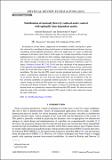Stabilization of unsteady flows by reduced-order control with optimally time-dependent modes
Author(s)
Blanchard, Antoine; Sapsis, Themistoklis P
DownloadPublished version (1.708Mb)
Publisher Policy
Publisher Policy
Article is made available in accordance with the publisher's policy and may be subject to US copyright law. Please refer to the publisher's site for terms of use.
Terms of use
Metadata
Show full item recordAbstract
In dynamical systems theory, suppression of instabilities around a fixed point is generally achieved by controlling the linearized dynamics of infinitesimal perturbations, because considering small-amplitude disturbances allows for application of a range of celebrated techniques from linear control theory. In this paper, we consider the problem of design and implementation of a controller for fully nonlinear, high-dimensional, dynamical systems with the goal of steering trajectories to an unstable fixed point of the governing equations. Our control strategy is based on our previous work [A. Blanchard, S. Mowlavi, and T. P. Sapsis, Nonlinear Dynam. 95, 2745 (2019)10.1007/s11071-018-4720-1] and takes advantage of the unique properties of the optimally time-dependent (OTD) modes, a set of global, time-evolving, orthonormal modes that track directions in phase space associated with transient growth and persistent instabilities. We show that the OTD control strategy introduced previously is robust with respect to perturbation amplitude even in cases in which the trajectory initially evolves on an attractor that lies far away from the target fixed point. In recognition of the fact that actuation capabilities are generally limited in practice, we also formulate a localized control strategy in which the OTD modes are computed in a spatially localized subdomain of the physical domain of interest. We suggest a strategy for selecting the optimal control domain based on a quantitative criterion derived from the OTD modes. We show that even when the range of the controller is reduced, OTD control is able to steer trajectories toward the target fixed point.
Date issued
2019Department
Massachusetts Institute of Technology. Department of Mechanical EngineeringJournal
Physical Review Fluids
Publisher
American Physical Society (APS)